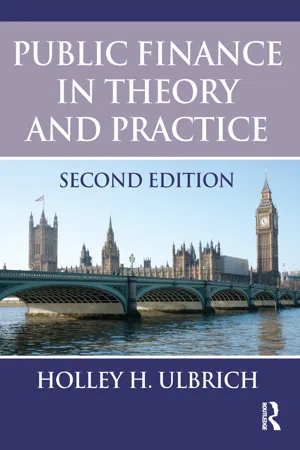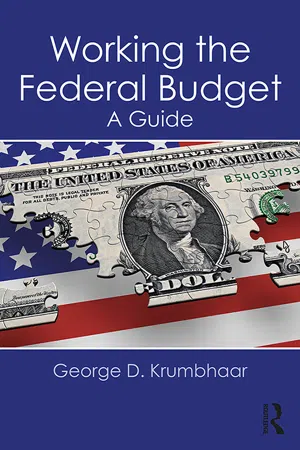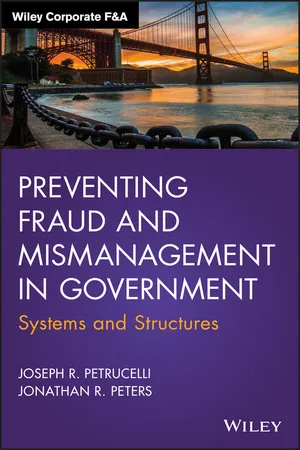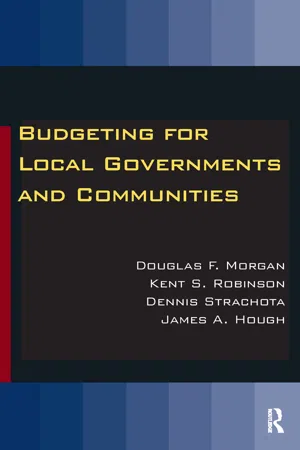Economics
Government Revenue
Government revenue refers to the income generated by a government through various sources, such as taxes, fees, and fines. It is used to fund public services and government operations, including infrastructure, education, healthcare, and defense. Government revenue is a crucial component of fiscal policy and is often a key indicator of a country's economic health and stability.
Written by Perlego with AI-assistance
Related key terms
6 Key excerpts on "Government Revenue"
- Holley Ulbrich(Author)
- 2013(Publication Date)
- Routledge(Publisher)
Part 3 Funding Government Taxes, Fees, and GrantsThe next seven chapters address the revenue side of government: the funds to pay for public programs, the distribution of the burden of paying for government, and the use of revenue instruments as means toward specific policy ends. The primary revenue source for government is taxes. Taxes are the focus of the next five chapters.The first two chapters explore the theory and practice of tax system design. The next three discuss each of the broad categories of taxes—income, sales, and property. The final two chapters in this part examine two other important revenue sources, fees and charges and intergovernmental grants.According to Justice Oliver Wendell Holmes, taxes are the price we pay for a civilized society. That dictum still leaves room to argue over whether the taxes are too high relative to the amount of civilization that citizens want or need or actually receive in return. It does mean that taxes are an inevitable part of living in society. Given the necessity of taxes, it is the economist’s task to provide some guidance in designing a tax system that minimizes the undesired side-effects of collecting them (efficiency) and apportions the burden in some way that addresses the equity concerns raised in Chapter 5 .Although taxes are still the primary form of revenue for governments at all levels, they are not the only source. Fees and charges, discussed in Chapter 16 , are a second and increasingly important way of paying for services that have some advantages in terms of both efficiency and equity. In both unitary and federal systems, intergovernmental grants represent an important supplement to own-source revenues for lower levels of government, a subject addressed in Chapter 17- William Duncombe(Author)
- 2018(Publication Date)
- WSPC(Publisher)
Lecture 9
Revenue Forecasting and Evaluation Criteria
9.1Introduction
The third part of this course will be devoted to examining Government Revenue sources. We will, over the course of the next few classes, try to familiarize you with the structure of some of the major taxes used in this country. Significant attention will also be devoted to the evaluation of these revenue sources. Since taxes have a significant effect on the private economy, it is important to understand their impact on private households and business firms. Much of the research on taxation has focused on evaluating the equity and efficiency effects of different government taxes. For example, do poorer taxpayers bear a disproportionately high burden of a certain tax? What impact does a particular tax have on consumer and business decisions? As a city manager or legislative staff person, you may be directly involved in making tax policy decisions. Even if you are not directly involved in tax policy or administration, many public agencies are introducing fees and charges as a means of boosting revenues. It is important that you know some of the right questions to ask in evaluating different revenues.We begin this lecture with a brief description of the tax system in this country. The tax system — reflecting our complicated federalist system — is a complex web of different tax types used by different levels of government and revenue sharing between levels through intergovernmental grants. We will then turn to a brief discussion of revenue forecasting, which is a crucial part of the budgeting process. Finally, the bulk of the lecture will be devoted to a discussion of the criteria typically used to evaluate tax policies and Government Revenue sources.9.2Overview of the Tax System
As you are well aware, the US has a very diverse system of government, with the federal, state, and local governments each playing an important role in the provision of public goods and services. Although federal, state, and local governments spend similar amounts of the total public budget, they finance these expenditures with significantly different revenue sources. As illustrated in Table 9.1- eBook - ePub
Working the Federal Budget
A Guide
- George D. Krumbhaar(Author)
- 2017(Publication Date)
- Routledge(Publisher)
In the current budget debate there is bipartisan support for major revisions in the tax code, even if there is little agreement on the specifics. This section looks at how tax legislation comes to the floor, and why major revisions are hard to come by. Revenue Sources The federal government has two major kinds of income. They consist of: • Government receipts. These include personal income and corporation taxes, customs duties, estate taxes—in fact, anything the government gets through the exercise of its sovereign power. • Offsetting receipts and offsetting collections. These are funds the government gets when it acts more or less like a business selling, say, electricity (TVA), vacations (national park access), and books (the budget). These distinctions are important enough that the money from them shows up in different parts of the budget. Government Receipts The federal government collected approximately $2.2 billion in tax revenues in FY 2015. Figure 9.1 shows that the largest components were personal income taxes, which formed almost one-half of all receipts, and “social insurance taxes and contributions” such as Social Security and unemployment trust fund income. Corporation income taxes formed a large, but significantly smaller share of the total. Federal excise taxes, at three percent of the total, covered such items as federal taxes on alcohol and tobacco. Customs duties, which in the early years of the Republic formed the largest share of federal revenues, now form approximately one percent. Estate and gift taxes, while politically sensitive, were less than one-tenth of one percent of total federal revenues - Richard Allen, Richard Hemming, B. Potter, Richard Allen, Richard Hemming, B. Potter, Richard Allen, Richard Hemming, B. Potter(Authors)
- 2013(Publication Date)
- Palgrave Macmillan(Publisher)
The tax system has to be capable of delivering a reliable stream of revenue so that expenditure can be planned in the knowledge that necessary resources are available. In practical terms, since the demand for public spending tends to increase as countries become richer, the tax ratio – that is, tax revenue as a share of national income – should increase as an economy grows without requiring tax policy changes. 1 The tax system should also be flexible in the sense that revenue can be increased through policy changes to respond to new expenditure needs, shortfalls in other sources of revenue (such as resource income or foreign aid) and adverse developments in the availability or cost of financing. However, the theory of taxation is not traditionally concerned with these aspects of tax design, but rather with the characteristics of a tax system that is intended to meet efficiency and equity objectives, which are microeconomic concerns. That is not to say that efficiency and equity are unimportant when it comes to thinking about revenue, despite it being more of a macroeconomic concern. It will be much easier to collect additional revenue if the tax burden is judged to be a reasonable imposition on households and businesses, given what they can afford to pay and what they get in return. But more importantly, the structure of taxation can affect both the level of national income and its rate of growth, which in turn influences a tax system’s revenue yield and revenue growth. As a consequence, there is a clear macroeconomic pay-off to getting the microeconomics of taxation right. The purpose of this chapter it is to provide a brief overview of the structure of taxation that has emerged from many years of analytical and practical work on tax design and then to discuss the revenue-generating capacity of that structure- eBook - ePub
Preventing Fraud and Mismanagement in Government
Systems and Structures
- Joseph R. Petrucelli, Jonathan R. Peters(Authors)
- 2016(Publication Date)
- Wiley(Publisher)
Fine revenue tends to be expensive to enforce and collect. One should consider the cost of collection and net revenue in any fine type system. The simple example of a traffic ticket which may appear on the surface as a low cost revenue source—until one considers the full cost of policing and court costs. These all contribute to the fishbowl of varying revenue streams. The question that needs to be asked is whether or not these revenues are matched and the payments are made for the intended purposes, which is to enforce compliance. What are the controlling oversight factors in place in the government system and structure to avoid potential fraud and mismanagement of these funds?Fees
Governments apply fees to goods and services that they provide based in part on the idea that user pay is appropriate. They are commonly called user fees. Fees such as park admission costs, road tolls, driver's licenses, and vehicle registrations form a component of government funding that is growing due in part to a desire by elected officials in many areas to avoid raising taxes. Fee revenue can allow the government to provide special services to particular entities based on a cost recovery model of operation. People have options with user fees, whereas with taxation they do not.Fees have several advantages, as they can be targeted to produce revenue from people who want a particular service. In many cases, a government can actually provide useful services to the public at lower cost than private‐sector providers or individuals. For instance, in many areas of the United States, household water supply is provided by individual well drilling and pumping by homeowners. In regions with sufficient population density, the government can use the ability to borrow funds at favorable rates coupled with their organizational skills to build a general water supply system. Users can then pay for their access to and use of these systems based upon their volume of use. Fees can be set to encourage conservation and recover costs. The net effect is that a system that serves particular users can be funded while not burdening all taxpayers with the cost of a service some are not using. - eBook - ePub
- Douglas Morgan, Kent S. Robinson, Dennis Strachota, James A. Hough(Authors)
- 2017(Publication Date)
- Routledge(Publisher)
Exhibit 6.1 displays an estimate of the relative share of the major sources of local governmental revenues for all U.S. local governments in 2009. The exact balance of the different continuing revenue sources used by a local government will vary with the fiscal year. Economic cycles of growth and recession will cause an ebb and flow in sales, income, and business tax revenues.Exhibit 6.1 Local Governmental Revenues by Source, 2009, for All U.S. Local GovernmentsSource: U.S. Census Bureau, 2009 . Table 1: State and Local Government Finances by Level of Government by State.The wide variation in size, state tax regulations, and purpose causes an individual local government to deviate from the national averages in Exhibit 6.1 . State property tax limitations may lessen the contribution of property taxes as a revenue source. State law may or may not authorize a jurisdiction to impose a retail sales tax or an individual income tax. Enterprise revenues from water and electricity utility sales, recreation facilities, or transit district fares may contribute an identifiable and substantial share of a government’s total revenues. The size and stability of enterprise revenues, as well as policy decisions on how to use enterprise profits to subsidize other governmental functions, determines the continuing revenue base on which to size an organization and its procurement.Revenues related to one-time activities and to one-time short duration revenues serve to supplement and complement a local jurisdiction’s continuing sources of funding. The flow of borrowed revenues from bonds and financial notes often will follow the start-up, construction, completion, and lifespan of capital construction projects. Grant revenues from the federal and state governments will increase intergovernmental revenues over the lifecycle of the grant. Some grants provide local governments with continuing revenues on a permanent basis, while other short-term grants last for only one to several years. Administrators and elected officials should recognize that short-term, one-time grants from public and private sources provide only a supplement to continuous revenues or recurring revenues. The revenue balance that supports a jurisdiction adjusts over time, but increasing the diversity of both recurring and one-time sources of revenue should stand as a strategic goal (NCSL 2007b ; Krane, Ebdon, and Bartle 2004
Index pages curate the most relevant extracts from our library of academic textbooks. They’ve been created using an in-house natural language model (NLM), each adding context and meaning to key research topics.





